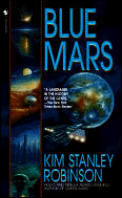
| Series: | Mars #3 |
| Publisher: | Bantam |
| Copyright: | July 1996 |
| Printing: | July 1997 |
| ISBN: | 0-553-57335-7 |
| Format: | Mass market |
| Pages: | 761 |
Blue Mars is the third and final book in Robinson's trilogy about the colonization and terraforming of Mars. It builds heavily on the characterization and politics of the previous two books and would be nearly incomprehensible to someone jumping in at this point. Reading this series is a major project, and I'm afraid you don't get to take shortcuts.
Green Mars was a definite improvement on Red Mars, with more tension, more of a plot (once it finally got started), and more to draw in the reader. I was hoping that Blue Mars would continue the trend. Unfortunately, it felt more like Robinson ran out of plot.
He certainly didn't run out of ideas, and Blue Mars continues his sprawling paean to research. Not just terraforming but speculation about the results in an Earth-wide sea level rise, soil science, color theory, low-G flying, extreme weather, alternative government models, the biology of memory, and grand schemes for making Mercury, Venus, or the moons of the gas giants human-habitable fills the pages, along with endless minutia of Martian geography. Some of the bits of research are fascinating, and at their best they combine the scientific love of discovery with excellent characterization. My favorite section of the book was Sax and Maya trying to find names for the colors of the Martian sunset. Mostly, though, as in the previous books, they're slow and far too long, and the farther he develops his utopian Martian society, the less believable I found the sociology.
As with the previous books, each of the roughly 50-page sections is told from a tight third-person perspective on one of the characters. Ann and Sax get several sections, along with several other of the characters we've followed through the whole series and one new character (Zoya, one of the best segments of the book). Robinson knows his characters well and paints them vividly. Even with characters I found boring, like Ann, I was drawn a little into how they viewed the world. It's a good way to tell this sort of sweeping epic and establish multiple points of view.
The problem with all this is that Blue Mars is horribly long, horribly slow, and has very little purpose. Red Mars was the story of initial settlement, initial personality clashes, and the reaction of the explorers to a tighening grip from Earth. Green Mars was the story of a revolution, told slowly and meanderingly but with a satisfying climax. Blue Mars is supposedly about the further growth and development of the competing forces of ecology and development, of immigration and construction of a new social order, but it feels more like random stories about favorite characters. There is an extended wander around Earth that portrays a crowded planet with new eyes from the perspective of Mars natives, but which ultimately has little point. Zoya's tours of other terraforming operations in the solar system is interesting but irrelevant. The new political clash builds and ebbs, builds and ebbs, and then gets resolved in a fizzle nearly off-camera, in three pages of unparagraphed, largely unpunctuated dialog after the fact. Characters get the spotlight for fifty, a hundred pages to little purpose other than to explain in great detail their daily lives, worries, fears, and wants. It's all very thorough, but there's not much reason to keep reading unless you love Robinson's characters and want to watch them live their daily lives.
It's not that Robinson ran out of future developments so much as he ran out of conflict and action. Combine that with an additional 200 pages over the length of the already plodding Green Mars, and Blue Mars is, in a word, boring. It may be interesting stuff for someone who would be fascinated by non-fictional technical papers on terraforming science, but for those of us looking for a story, there are perhaps two or three hundred pages of satisfying reading. That's not much in a book of this size, and given the lack of any real climax, it's a hard slog to get even to those bits. A shame, since Robinson is a clearly skilled writer when his prose isn't clogged with excessive research or long-winded psychological rambling.
The cover blurb on my copy quotes The New York Times Book Review calling Blue Mars "a landmark in the history of the genre." I can't disagree with that, but it's often less the Hoover Dam and more the world's largest ball of twine: staggering, impressive, memorable for the sheer effort and devotion to twineness, and mind-blowingly pointless. It may be a success at research, the last word in hard SF terraforming, and even at times a beautiful character portrait, but for me it was a failure as a novel. If you loved Red Mars and Green Mars, you'll probably disagree and enjoy more of the same without the purpose. If you thought, as I did, that Green Mars was a step in the right direction but still horribly slow, give this one a miss. It's not worth the effort.
Reviewed: 2005-12-29